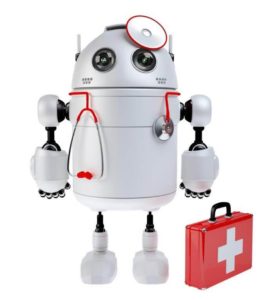
Technology makes everything better, right? With that thinking, newer methods of hair restoration, which use robotics or automation to help surgeons perform the procedure, must be the wave of the future.
But that’s not necessarily true. While devices such as Neograft and ARTAS have their potential place in the realm of hair restoration surgery, neither will completely replace the artistry that a surgeon can achieve performing parts of the procedure by hand.
The Basics of FUE
Follicular unit extraction, or FUE, is the hair restoration technique that both ARTAS and Neograft help in the performing. When a surgeon performs FUE, the hair follicles are harvested from the scalp one by one. The technique avoids the long scar that is left behind by other methods, such as follicular unit grafting. While not suitable for everyone, FUE is ideal for patients who don’t mind shaving their head for the procedure, assuming a large number of grafts are to be transplanted. The procedure is also commonly used for obtaining hairs for transplanting to the beard and sometimes the eyebrows.
It’s important to understand that FUE hasn’t replaced follicular unit grafting, or FUG. Instead, it provides another option to patients. The same is true of procedures that use ARTAS or Neograft to help a surgeon performing FUE.
What Is ARTAS?
ARTAS is a computerized, robotic system that was FDA approved for use in hair restoration surgery in 2011. Instead of the surgeon choosing which hair follicles to harvest, the ARTAS system evaluates the hair and, based on programming, chooses the follicles that it identifies as being the best for transplantating. The device then harvests these follicles from the donor area.
Understanding Neograft
The big difference between ARTAS and Neograft is that Neograft isn’t robotic or computerized. Instead, it is a hand-held device meant to add some automation to the process of extracting hair follicles. The device uses pneumatic pressure to remove the hair follicles from the donor sites. Neograft is meant to speed up the process of FUE, although top FUE practices can extract grafts just as efficiently. Many of the practices that utilize this device purchased it so that it could perform FUE procedures for the first time, and sometimes to do any hair transplant procedures for the first time.
Not a Replacement for the Human Touch
Once the hair is extracted, the surgeon needs to transplant it into the recipient sites. It is here that the human eye and human touch are most important, as the surgeon needs to understand how to position the hair so that it will grow back in a way that looks natural. No patient wants to end up with a head of hair that is anything less than natural.
Another potential drawback of some of these devices is that they push the surgeon out of the driver’s seat. In some cases, technicians take over the process of extracting the hair and even preparing the recipient areas- a critical step that the top hair restoration surgeons perform themselves.
Final Thoughts
In the world of hair restoration, there’s really no one-size-fits-all option. Devices such as Neograft and ARTAS have their benefits and deserve a spot in the operating room in some cases. But, those devices will never fully replace the surgeon’s touch or eliminate the need for multiple techniques.
Dr. Jeffrey Epstein has been performing hair restoration surgery, including both FUG and FUE techniques, for over two decades. With practices in Miami, he is available to answer questions about the differences between FUG and FUE, and to help patients determine which solution is best for them. To schedule an appointment with Dr. Epstein, call (305) 666-1774 in Miami.
